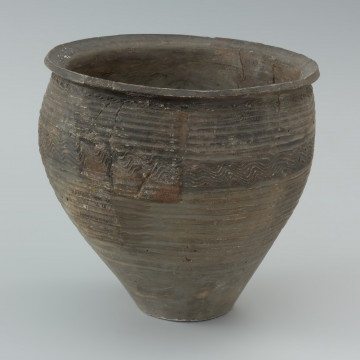
Type G ornamented vessel (Łosiński, Rogosz 1983, 1986)
951 — 1250
National Museum in Szczecin
Part of the collection: Middle Ages
The clay lid was discovered during excavations carried out at the end of the 19th century on a barrow burial ground in the south-western part of Wolin on the so-called Wzgórze Wisielców (Hangman’s Hill, or Galgenberg). Clay lids are relatively rare finds. This was most likely due to the long and unprofitable production process, since wooden lids were relatively simpler and quicker to make. It is possible that small pieces of cloth were also used to cover the openings of the vessels. Clay lids found during the excavations were usually an integral part of tubular containers with characteristic inward-curved spout edges, used in thte 11th-12th centuries. They were made on potter’s wheel in their entirety. Their surfaces were usually decorated with lines of grooves, wavy lines, punctures and dimples, going around the entire vessel. Occasionally, braided patterns are also discovered. Often, intentionally-made notches can be seen on the edges of lids and vessels to mark the location where they have to be put to properly seal the vessel. A lid from Wolin has the shape of a cone formed on a potter's wheel. The lid is topped with a decorative handle resembling a button.
Grzegorz Durdyń
Author / creator
Dimensions
cały obiekt: height: 5.2 cm, diameter: 9.5 cm
Object type
lid, culinary equipment
Technique
printing, modelling
Material
clay
Origin / acquisition method
acquisition
Creation time / dating
Creation / finding place
Owner
Muzeum Narodowe w Szczecinie
Identification number
Location / status

951 — 1250
National Museum in Szczecin

476 — 1250
National Museum in Szczecin

801 — 1100
National Museum in Szczecin
DISCOVER this TOPIC
Museum of King Jan III's Palace at Wilanów
DISCOVER this PATH
Educational path